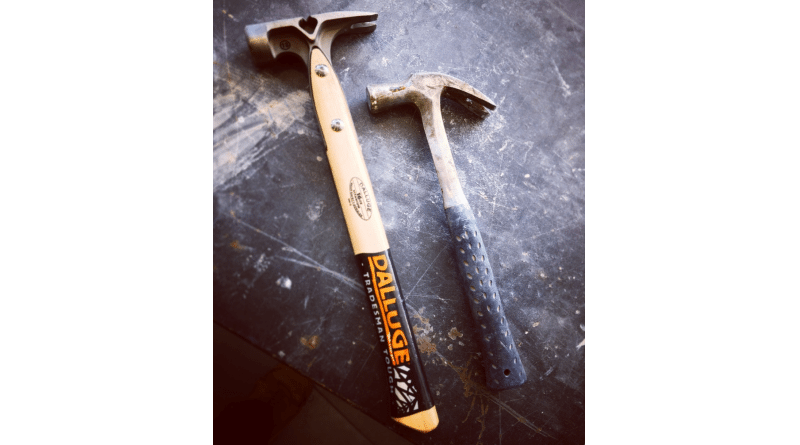Stop: Hammer Time!
One of the oldest tools known to mankind (and frequently the oldest tool in the toolbox) the hammer is in daily use for most carpenters, remaining largely unchanged for hundreds of years. Then, in 1998, Mark Martinez invented the titanium framing hammer, the Stiletto. Claims have since been made about the reduction in weight married with an increase in productivity and arguments rage about the high price of the tool… so are they really worth the extra money?
I have been using an Estwing 24oz happily for the last 15 years with no complaints (the only reason I bought new was because I lost the old one). My weight of choice was the 24oz, simply because I felt it would be a good all rounder – heavy when you need it, gentle when you want.
In recent times I’ve noticed a bit of an ache in my forearm after long periods of hammering (joist hangers without a PPN gun, always a killer) and I began to wonder if it was me getting older, or my choice of hammer. Probably both. So I did some research and ended up plumping for Vaughan Dalluge (pronounced “dah-loo-gie” apparently) DD16T for £133 from bigredtoolbox via eBay. I decided on this because it has a wooden handle – widely regarded as one of the best materials for shock absorption – and a light (16oz/456g) titanium head.
First impressions when I opened the box were “this is going to break, it feels far too light to be strong…” but… it’s not a pry bar or sledgehammer. If you snap a solid hickory handle: you’re doing it wrong. In the hand it feels perfectly balanced, with a good length handle. The large sticker feels a little slippery compared to the rubberised Estwing grip, which took a little getting used to. I’ll probably peel that off.
As for actually driving nails – it is a sensation. I immediately get what all the fuss is about. The handle absorbs shocks so well you barely feel you’re making contact, and the titanium head seems to ‘ping’ the nails in easily as well as the heavy Estwing; if not better. Driving 3″ and 4″ nails into several bits of timber (and an oak stump) the Dalluge sinks the nails either in the same amount of hits, or less. You never feel like you have to really put your back into it either – the hammer is doing the work. Back to back testing has made it clear – the Estwing is resigned. My arm thanks me.
Some of the principle behind a lighter hammer is that you can swing it faster using the same amount of energy – and if you can swing a hammer twice as fast you will increase its kinetic energy by a factor of four. The same is true for a lightweight steel hammer, but with the density of steel being so much higher than titanium, manufacturers struggle to make the striking face of the hammer large enough for the task at hand, whilst keeping the weight down. This is where titanium steps in. It is almost as hard as steel (Mohs hardness of 6 for Ti, 5-6.5 for steels), but has more flex (anyone who has ridden a titanium framed bike will know what I mean). This attribute alone could contribute positively towards energy transfer into the nail, but by how much is difficult to measure. At least on a site.
RSI and tennis elbow is not caused singly by swinging a hammer, otherwise all carpenters would get it. That said, you are unlikely to injure your arm if you never swing a hammer. “There are too many variables with injuries of this nature to accurately say that hammer weight alone reduces the risk of injuries” says Belfast-based physiotherapist Conall Toland. “There are no studies that currently exist that test the effect of a heavier hammer vs a light hammer over a period of a year – or more importantly – a lifetime.” The advantage of a lighter hammer (and this could be said for light steel hammers too) is that you will reduce the amount of fatigue on your arm – and even your body if you carry your hammer at all times – less fatigue means more energy, for whatever it is you use your arm for after work…
So let the distinction be clear – no hammer can guarantee to reduce the risk of injury, but we can see that with less energy you can do the same amount of work, and reduce the stress on your body significantly.
What’s not to like?
Steve Holyoake.



Good read . I’ve been on the verge of going titanium for a while but convincing myself that it’s all just great marketing by ‘Martinez’ but one of our apprentices got the same hammer I think as you’ve described snd I really liked it so just doing some research now on the titanium hammer to go for .👍
Glad Steve’s article has helped you Sandy! Let us know what you end up with!